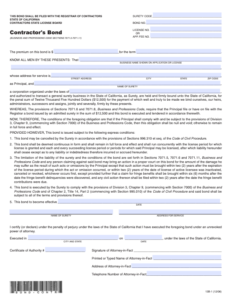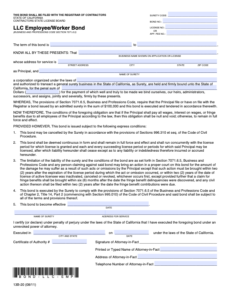
Surety Bond Forms: A Complete Guide
No one likes reading paperwork, and surety bond documents can be particularly confusing at first glance. This guide will help you understand what exactly a surety bond form is, how to obtain one, and how to read the form so that you don’t miss bond requirements that impact your coverage.
What Is a Surety Bond Form?
A surety bond form is a legal document that highlights all the details pertaining to a particular surety bond, such as the cost, coverage, and legal responsibilities for the parties involved, as well as other identifying and record-keeping details. It’s essentially a written contract between three parties (an obligee, principal, and surety) that the bond was purchased and its terms will be upheld. Contractors need this form when acquiring a variety of bonds, such as license bonds, contract bonds, and permit bonds. To ensure the bond form is filled out correctly, the principal needs to first understand all the different elements on the form.
How to Obtain a Surety Bond Form
Luckily, a surety bond form is typically quick to obtain, as it can be electronically signed online in many cases. For contract bonds, the principal will typically obtain the bond forms required for the project from the obligee, while for other bonds, such as a contractors license bond, your broker will typically have the correct bond forms on file.
While the process of completing a bond form varies slightly depending on the type of bond, your broker will be able to quickly guide you through the process. Bond forms are legal contracts, so in addition to making sure you have the right bond forms, it’s important to understand what’s on the form, including the principal’s rights and responsibilities, as well as verifying it meets all the requirements stipulated by the obligee.
Common Types of Bond Forms
There are multiple types of surety bond forms you may come across, with the most popular for contractors being forms 13B-20 (Contractors LLC Employee/Worker Bond) and 13b-1 (Contractors License Bond). While the surety you work with typically completes these bonds for you and can act as an expert on the requested fields, it’s important you’re also familiar with the components. See the images below for an overview of the information requested on these forms, and read on for information on bond clauses and other form features.
Contractors License Bond
Contractors LLC Employee/Worker Bond
What Are the Essential Parts of a Surety Bond?
Below are the components you’ll need to know to complete the typical bond form, so have the following information readily available to expedite the process. Other elements to have on hand are the principal’s name, surety’s name, obligee’s name, and state of incorporation.
Bond Number
The bond number is the identifying number assigned by the surety company to a bond. This number will tie your application to the correct bond.
Bond Premium
The bond premium is the cost of the bond being purchased. This can either be paid in full upfront or in some instances depending on the bond type, may be paid over time through a payment plan. Note that this is different from the bond amount described below.
Bond Amount
The bond amount required is determined by the obligee. The amount of liability coverage for your bond must be written out and/or listed numerically.
Bond Obligation
The obligation is the purpose of the bond and the agreements associated with it. This is where the requirements of the bond and what it covers are listed. For example, a California contractor license bond may require the license type or classification to be listed.
Bond Period Beginning and End Dates
This refers to the period during which the bond is effective. Keep in mind that the obligee determines how the bond is written, so an end date may not be on the form.
Bond Form Number
This number shows which type of obligation the bond fulfills. It can usually be found along the bottom of the form. Obligees can reference this number to determine exactly what license or registration this bond is for and the specific terms that apply to each type of bond.
Common Bond Clauses to Understand
Bond clauses you may see on a bond form include the following.
Binding Clause
A binding clause often begins with the words “Know all men by these presents,” along with the name of the surety, principal, and obligee. These clauses state the principal and surety’s obligation to the obligee and may include the bond amount.
Condition Clause
A condition clause typically begins with the phrase “The condition of this obligation such that.” This clause will state the type of business license applied for and the underlying agreement the bond guarantees.
Now, Therefore Clause
This clause essentially states that if the principal doesn’t make valid claims against the bond by the end of the contract term, the bond will expire.
Provided, However Clause
Some bonds include this clause to add further provisions that identify:
- How the bond can be canceled
- If the bond can be continued by a continuation certificate
- The surety company’s liability
Lack of Aggregate Liability Clause
This clause limits the surety’s liability to the bond amount, regardless of how many claims are made. Bonds with an aggregate liability clause limit the surety company’s maximum liability to the bond amount, while bonds that don’t contain this clause hold the surety company liable up to the full bond amount for each claim made.
Lack of Cancellation Clause
This explicitly states the number of days the surety must provide the obligee with notice when a cancellation occurs.
Demand Clause
A demand clause limits the amount of time a surety has to respond to a bond claim.
Forfeiture Clause
This allows obligees to demand that the surety pays the full bond amount, regardless of the size of the loss.
They may not be glamorous or fun, but obtaining a bond form is a necessary and valuable part of ensuring you’re set up for business success as a contractor. Surety First can help you walk through every step of the surety bond process to ensure your bonds meet all the requirements you need them to. Contact our bonding professionals today to get your surety bond questions answered or for a bond quote.
HAVE BONDING QUESTIONS?
Call us today at 1-800-682-1552 to speak with a licensed contractors bond specialist.
Mon-Fri 8:30am-5:00pm
Or








